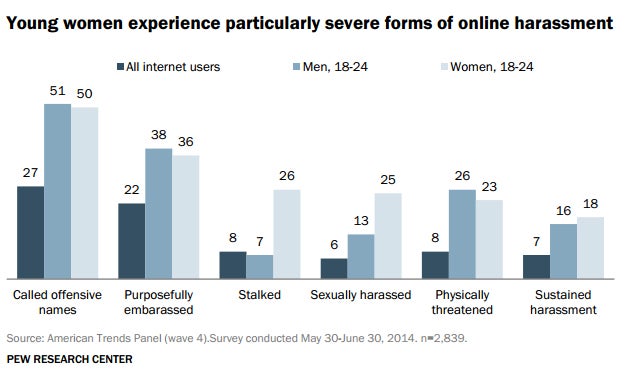A new study into the phenomenon of online harassment reveals that 73 percent of Internet users have witnessed or experienced online harassment—and when it comes to severe harassment, women are more likely to be harassed more often.
And the most toxic environment to be a woman online? Gaming.
The Pew Research Center revealed results on Monday from its first poll on the subject of Internet harassment. The poll’s 3,200 respondents fell into two broad groups: those who have seen other people stalked and harassed online, and those who’d experienced it firsthand. The types of harassment ranged from mild harassment like name-calling and attempts at embarrassment to more severe forms like stalking and sexual harassment.
Forty percent of respondents believed that they had experienced harassment firsthand, and 18 percent said that they had experienced more severe forms of harassment.
But perhaps even more alarming than the fact that four in 10 people were likely to be harassed is the study’s findings that serious harassment was more likely to occur to women—particularly young women ages 18 to 24. (The poll did not survey respondents younger than 18).
The study found that women ages 18 to 24 were three times more likely than men in the same age bracket to be victims of stalking online. Young women were also nearly twice as likely to be sexually harassed as young men.
Women were also more likely than men to report that their most recent experience of online harassment was extremely or very upsetting. Thirty-eight percent of harassed women described their most recent experience as extreme or very upsetting, compared with just 17 percent of harassed men.

Image courtesy of the Pew Research Center
While milder forms of harassment like embarrassment and insults applied fairly equally to both men and women, men were more likely than women to be physically threatened. And men overall were slightly more likely to experience all forms of harassment.
However, a key finding of the study showed that the more open you were online, the more likely you were to be harassed:
[T]hose whose lives are especially entwined with the internet report experiencing higher rates of harassment online. This includes those who have more information available about them online, those who promote themselves online for their job, and those who work in the digital technology industry.
Online communities also affected harassment. Women and young adult respondents were more likely than others to experience harassment on social media, while men, particularly young men, were more likely to be harassed while gaming.
Pew Research Analyst Maeve Duggan told the Daily Dot that the criteria for witnessing harassment occurring online was broad. Write-in respondents to the poll described everything from real-time incidents on social media or during online gaming to watching antagonism unfold in the comments to news articles or on Internet forums. Sixty percent of internet users said they had witnessed someone being called offensive names, while 18 percent said they had seen someone be stalked. Twenty-seven percent of internet users said they themeselves been called offensive names, while 8 percent or fewer reported being stalked, sexually harassed, or harassed for a sustained period.
Respondents were also polled on various social platforms and other Internet communities in terms of which spaces were safer or more prone to harassment. Sixty-six percent of respondents said their latest experience of harassment had occurred on a social networking site or app. The second-most likely location for harassment to occur was on the comments section of a website. Perhaps surprisingly, the least likely location for their most recent site of harassment was an online dating website or app.
In general, respondents agreed that online spaces allowed for more critical discourse, more supportive interactions, and more anonymity than offline spaces. But they also felt that some online spaces were more welcoming than others. When it came to online gaming communities, only 3 percent of respondents believed the environment was more welcoming to women, while 44 percent felt it was more welcoming to men.

Image courtesy of the Pew Research Center
Notably, the Pew Survey discussed the impact of #GamerGate, revenge porn, and other instances of online harassment on women’s ability to feel safe online. It also noted that very little research has been done on online harassment, and most of that has focused on teen activity and experiences. Many of the write-in respondents in the survey also expressed concern for teenagers, both as the perpetuators and victims of harassment.
The entire survey can be read online at the Pew Research Center website.
Photo via Helga Weber/Flickr (CC By ND 2.0)
